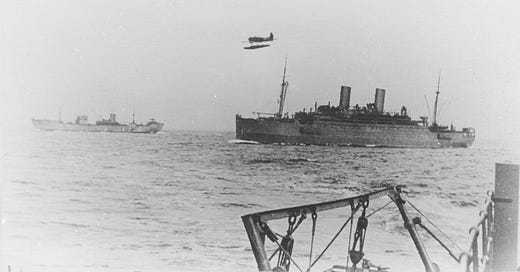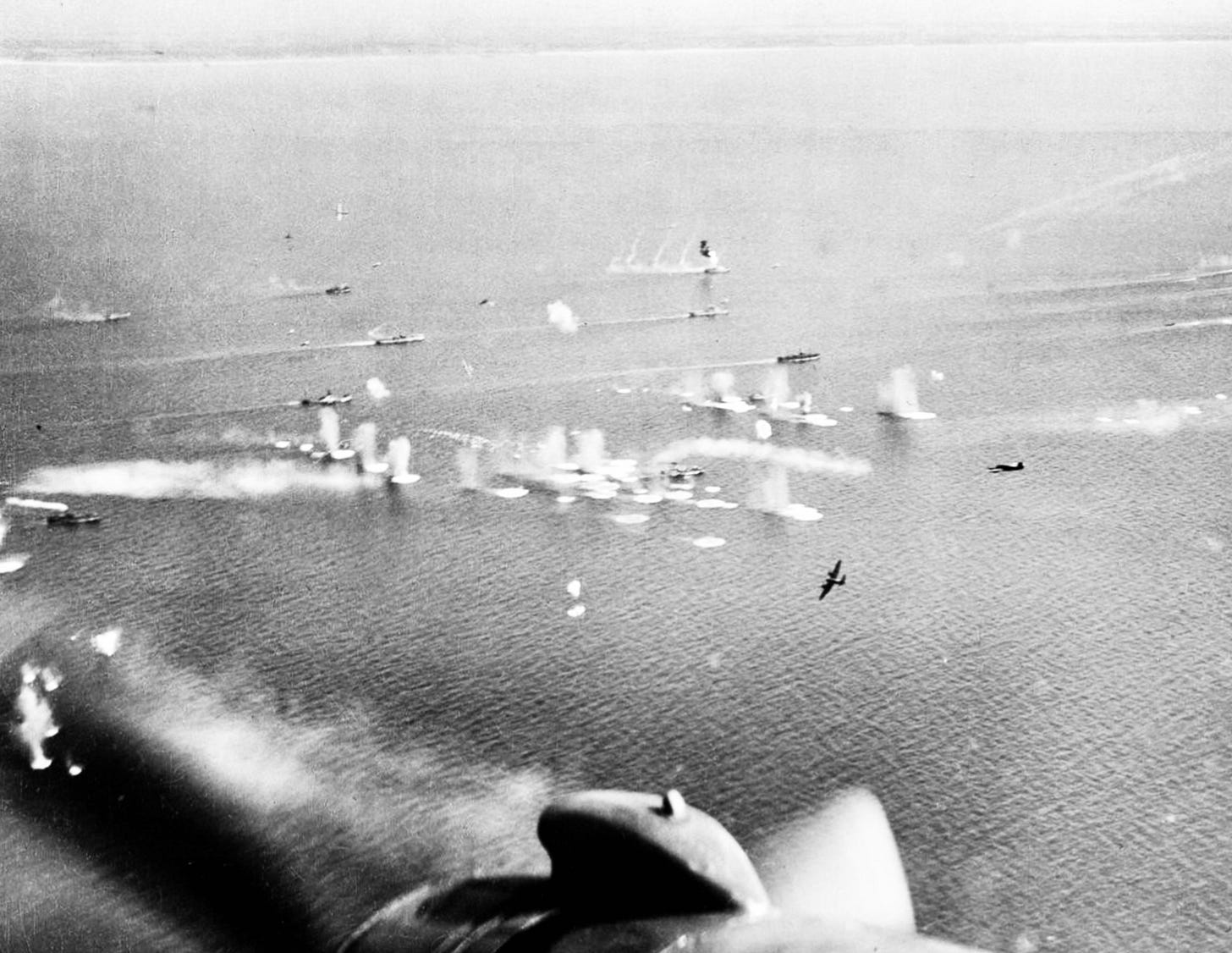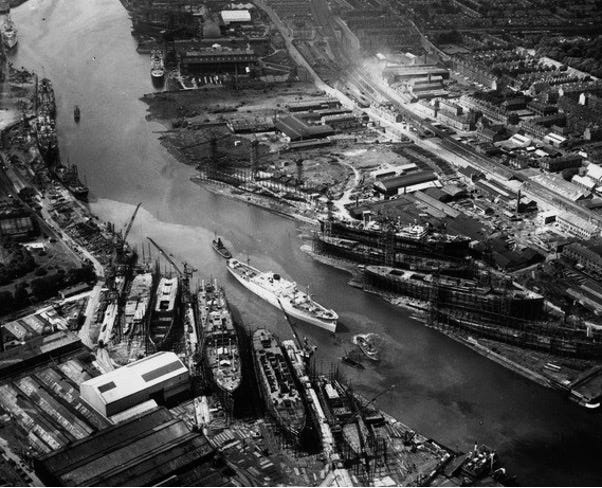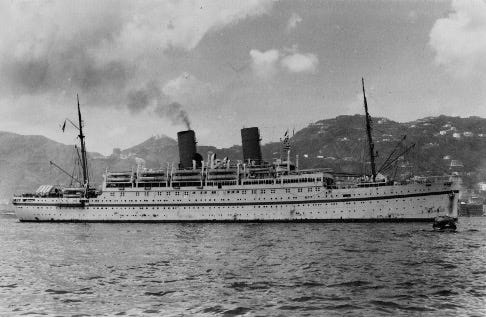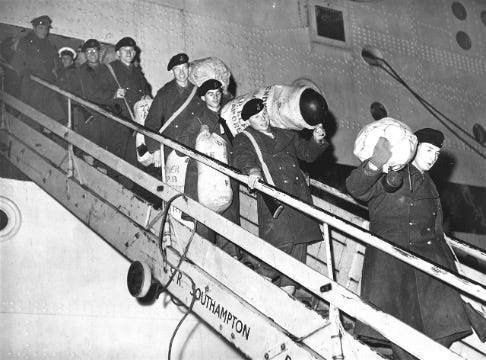The Monte Rosa and Empire Windrush - the Full Story and Other Tales
Part 5: The Monte Rosa at War
M.V. Monte Rosa - Troop-ship, Probably Baltic or North Sea - 1942-44
Credit: Unknown
The Monte Rosa had a similar wartime experience to the Gustloff, but left its berth on many more occasions. She joined the war fleet on 11th January 1940, and her first commission was as a barrack-ship in Kiel or at Stettin. She would go on to ply the various routes between the German ports in the Baltic, along with those in Denmark and Norway, ferrying troops and officials into and out of theatre, and also many troops to enjoy home leave. It is also known that in November 1942, she carried a number of Jews out of Norway for onwards transportation to Auschwitz1.
It was not just German troops that the Monte Rosa transported. Whilst the vast majority of Norwegians did not offer the Germans much allegiance, there were nearly 2,000 Norwegian fascists - or chancers - who joined the ‘Norwegian Legion’, which was deployed to Russia. The Monte Rosa certainly carried these troops back to Norway in April 19432 after the unit was disbanded, and it is quite possible she had shipped them there too.
From autumn 1943 to spring 1944, she attended upon the Tirpitz in the Norwegian fjords after the battleship - nicknamed ‘the Beast’ by the British - was attacked by charges placed under her hull by British midget submarine crews on 22nd September 19433. The Tirpitz was not sunk, but was seriously damaged and would require many months of repairs. There was no dry-dock in Norway so repairs were carried out in the fjord. The Neumark was her repair ship whilst the Monte Rosa was used to transport, and then accommodate, 750 ship-workers from Kiel to Kaafjord to do the work4.
Monte Rosa was well-known to the Allies as a valuable enemy asset in the Norwegian theatre. Consequently, attempts were made to sink her usually in tandem with specific intelligence from the Norwegian resistance. On 30th March 1944 nine Bristol Beaufighters of RAF 144 Squadron and nine more of RCAF 404 Squadron, both operating out of RAF Wick in north Scotland, were deployed across the North Sea to seek and destroy her. The Germans always moved their important ships with escort vessels and air cover and on this occasion, when the eighteen Beaufighters found their target near the Norwegian island of Utsira, they were met with formidable resistance from over a dozen Luftwaffe fighters and flak from destroyers and two other escorts. Nevertheless, the attack was prosecuted vigorously, and two torpedo hits and numerous rockets strikes were recorded for the loss of two aircraft - but only one crew5. The photo below is not of the mission referred to.
Bristol Beaufighters Attack German Shipping off Norway - 1944
Credit: Unkown
The Monte Rosa limped into Aarhus in Denmark for repairs and was put out of service for a while; but not for too long though, because by June she was back in action. Again, Norwegian resistance and British SOE operatives learnt that she would be transferring 3,000 German troops from Oslo back to Germany and decided to spring another, different, attack. With no small effort, two Norwegians secreted themselves inside the docks for three days and later emerged to covertly place limpet mines on her hull. They detonated whilst she was at sea, but once again, the Monte Rosa did not sink - clearly, Blohm + Voss had built her very well.
The five-year German occupation of Norway, saw about 300,000 troops and officials stationed there. Inevitably, in that time, several thousand Norwegian women forged relationships with members of the occupying forces and many gave birth to ‘German’ - ‘Lebensborn’ - children. In August 1944, as the war headed towards its denouement, Hitler ordered that such ‘German’ women and their children would be evacuated to Germany, and the Monte Rosa was deployed for such duties6. On one of these missions she struck a sea mine and suffered an ingress of water so serious that the skipper had to close the water-tight doors to save the ship, but in the process drowned some 200 women and children in the lower part of the ship.
Again, the vessel was repaired again, most likely at Swinemunde, and then in January 1945, she became a hospital ship, but was not officially designated such. Almost certainly, she was engaged in Operation ‘Hannibal’, because on 16th February - two weeks after the Wilhelm Gustloff disaster - she struck another mine off the Hel(a) Peninsula whilst carrying 5,000 German refugees away from Gotenhafen (perhaps the judgement of the Gustloff’s Captain Petersen was not so flawed).
This ended her war. She went back to Gotenhafen for temporary repairs, and thence made it to Copenhagen - where she was found when the war ended, and from where she was towed to Kiel in June.
In August 1945, the Potsdam Conference established the Tripartite Naval Commission (TNC) and Tripartite Merchant Marine Commission (TMMC), to make inventories of extant German shipping. Simultaneously, each commission would survey each ship’s condition and utility and then the tonnage would be divided up between the Allies.
The TMMC worked tirelessly from 1st September to 7th December 1945, and reported in early-1946. As the former Minister of War Transport, and post-war Minister for Transport, Alfred Barnes, announced in the Commons on 18th March 1946;
“The Tripartite Merchant Marine Commission in Berlin divided ex-German ships into three shares. The number of ships allocated to the United Kingdom was 147 of 435,000 gross register tons. The United Kingdom and United States governments have agreed to provide out of their shares appropriate amounts for other Allied States whose merchant marines have suffered heavy losses in the war against Germany, except that the U.S.S.R. has undertaken to make provision for Poland out of her share. This re-allocation of the United Kingdom and United States shares will be undertaken by the Inter-Allied Reparation Agency in Brussels. The ships finally allocated to the United Kingdom will be at the complete disposal of His Majesty's Government”.
The work of the TMMC did not mean that merchant vessels were kept idle until allocated. Immediately post-war, one unconfirmed source7, has the Monte Rosa ferrying British POWs home across the North Sea, with German ones carried in the opposite direction. Another version has her towed from Kiel to Jarrow on the River Tyne. Whichever is true - and both could be - this resilient German vessel was allocated to the British and passed to the Ministry of War Transport (MOWT). After a refit she would be utilised as a troop-ship.
Clyde Shipyards - Glasgow 1948 - Alexander Stephen & Sons Yard Lower Left
Where M.V. Monte Rosa Became H.M.T. Empire Windrush
In spring 1946, the Monte Rosa, intact but very shabby, rusting and sad-faced, went from Jarrow - probably towed again - around the coast of Scotland and then up the Firth of Clyde to Glasgow and the ship-yard of Alexander Stephen & Son in Linthouse. Here she would be comprehensively repaired and refurbished as a ‘modern’ troop-ship. Her lower decks were given over for more refined troop accommodation, whilst the upper decks were designed for officers and military families. However, things did not go entirely smoothly, for in December of that year a fire ripped through her, and put back her completion until mid-March 1947. Nevertheless, the ship’s final era can be said to have officially commenced on 21st January 1947, when MV Monte Rosa was renamed HMT Empire Windrush8 and assigned the IMO No. 181561.
When WWII ended all three arms of the service - not forgetting the unofficial fourth arm, the Merchant Navy, whose contribution to the whole war effort was vastly under-appreciated - still had huge commitments. These commitments involved the transportation of the vast hordes of humanity that circumstances had cast to various corners of the world, and who now demanded they be put back in their place of origin. These groups included: Allied combat troops returning home to Britain9, to Commonwealth countries and to the USA; Allied prisoners-of-war (POWs) in Germany and the far east; British civilians interned in the far east and of course enemy POWs whose return had to be coordinated with authorities sorting out the chaos in Germany, Italy and the rest of Europe.
Then there were the administrators and specialists - not to mention food and materiel - that were sent out to the colonies to begin the process of rebuilding. Later, there was even a small programme to convey the tens of thousands of ‘war brides’ - accumulated by mainly US service personnel in all theatres - over to North America. The whole, staggering process of recovery, relocation and realignment10 would go on into 1946 and well beyond.
Even though the war had ended and the restoration work had commenced, the peace was uncomfortable if not fragile. Indeed, some countries - Iran, Greece, Palestine and Indo-China saw civil wars flare up almost immediately after the two armistices. The seeds of future conflict were sown as the major powers jockeyed for territory, resources and strategic, technological and ideological advantages.
As already noted, just as the WWI had destroyed the Hohenzollern, Hapsburg, Ottoman and Romanov monarchies, WWII meant the end for the empires of European nations. Colonial subjects of Britain, France and Holland grew restless for self-government and independence - often along Marxist lines. This was very actively encouraged by the communist powers of USSR, and China, thereby challenging the equilibrium of what became the ‘Western powers’ - USA, outlining its ‘domino theory’.
WWII morphed into the Cold War. After 1945, British forces fought overseas almost continually for at least another twenty-five years. British troops were required all over the globe: from Germany, to Palestine, to Aden, to Kenya, to India, to Malaya, to Korea, to Cyprus, to Hong Kong and to Japan, there was a constant need to move soldiers and airmen around the world, sometimes with their families. Depending on their general age and condition, most British troop-ships were taken out of service at various times in the 1950s, but troop-ship movements went on until about 1962-3 when air transport became more viable - though the practice was resurrected when the QE2, Canberra and Norland were requisitioned for the Falklands campaign in 1982.
HMT Empire Windrush - Hong Kong, 1949
Credit: Unknown
In all, H.M.T. Empire Windrush would make nearly thirty round-trip troop-carrying voyages11: there were thirteen on the Far East route, ten to the Mediterranean and even four that were made 1947-8 to newly independent India - Bombay and Karachi - to effect the withdrawal of British officials, troops and civilians. She left India on 1st January 1948, slipping out of Karachi, and docked at Southampton 23 days later. There may have been another trip in between, but - most probably - her final trip to India saw her leave Bombay on 8th April, arriving in Tilbury after three weeks. Her very next trip would ensure the immortality of her name.
As a British troop-ship, the Windrush operated under the auspices of the New Zealand Shipping Co., and was most regularly deployed on the Southampton - Gibraltar - Port Said, Suez - Aden - Bombay - Colombo - Singapore - Hong Kong route.
HMT Empire Windrush - Outward to Singapore, 1950
Credit: Unknown
It was on passage between Gibraltar and Port Said in 1949, when the Windrush suffered a serious fire. The life-boats were all manned, but the fire was brought under control and they were not launched. The ship was towed back to Gibraltar. It was a portent of what was to come.
Other places the Windrush conveyed, troops and families, to and from included Malta, Famagusta (Cyprus), Mombasa and Salonika, from where in February 1950, she embarked troops of the Bedfordshire & Hertfordshire Regiment, the last British unit to leave Greece.
When the Korean War broke out later that year, her troop-carrying responsibilities were extended to Pusan in Korea and Kure and Yokohama in Japan. It was on the return leg of such a trip to the Far East that the stout ship met her end.
1st Battalion Green Howards Disembark After Three Years in Malaya - November 1952
Credit: Green Howards Museum
Lastly, a little trivia, on 15th June 1953, H.M.T. Empire Windrush was one of over 300 British, Commonwealth and foreign vessels to take part in the Coronation Fleet Review at Spithead - and she was the only ‘German’ vessel involved!

